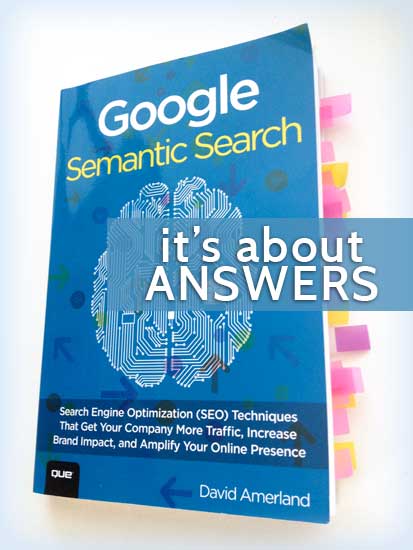Google Semantic Search – SEO Techniques From David Amerland
Google: an ANSWER Engine instead of SEARCH Engine

Pun intended.
The evolving semantic web is about answers and so is this book -the answers to our questions about SEO and search (plus a whole lot more).
“The pre-semantic web delivered links that were present on search because of the keywords contained in the pages they represented. The semantic web delivers outright answers and pages that are directly associated with the question we have typed in search.” David Amerland in Google Semantic Search, Que Publishing, 2013
In my ongoing quest to keep abreast of current search issues and SEO I recently read David Amerland’s book Google Semantic Search. In the photo above, you can see my enthusiasm and how valuable I found it by the number of post-it markers I used. You can’t see all the highlighting, but believe me, it’s there.
You can read my review of the book below. (you can see the review on amazon too)
What Does It Mean?
The word ‘semantic’ comes from Greek and is the study of meaning and the relationships between words, phrases, signs and symbols.
Semantic Search seeks to improve search accuracy by understanding searcher intent and the contextual meaning of terms as they appear in the searchable dataspace, whether on the Web or within a closed system, to generate more relevant results…. In most cases, the goal is to deliver the information queried by a user rather than have a user sort through a list of loosely related keyword results. Wikipedia
How Does This Affect Your Marketing Strategy?
This is a very deep topic but there are some straightforward actions you can take for your business to facilitate your best possible chances to meet the semantic web face-to-face and have the widest opportunities for being found online.
- Use Google+: Create a personal profile and a business page but don’t stop there. Get involved. Read posts and comment, create your own posts. Engage. Develop relationships. Be there…..
- Connect everything you do online: Make sure that all of your online activities are connected. Use Social Media! Cross-link your profiles on Google+, Facebook, Twitter, LinkedIn, Pinterest, YouTube and any other social channels you are on. Make sure your profiles are consistent, have the same contact information, use the same avatar. As David Amerland says, “cast a wide net“. All of your profiles should lead back to your website. Connect the dots. Create cohesion for yourself and your brand across all channels.
- Authenticate authenticate authenticate: Make sure you are building your authorship by connecting your Google+ profile to the content you create. Use rel=author tags on your blog and rel=publisher for multi-author blogs and/or your website. Remember, it’s all about giving Google as much information about you as possible. Make it easy to learn about who you are. This is how you will build your reputation and trust in who you are.
- Be the authority you are: You are passionate about what you do. You are bright and know your stuff. Don’t be afraid to let that shine. Take every opportunity toward building your public authority.
This brings us back to basics:
- Have an appealing, relevant and up-to-date website that delivers what your customers need, offers a positive experience with easy to use navigation and is an authentic representation of your company.
- Keep it fresh by producing quality content on your blog.
- Promote your content wisely across all your social channels. Find creative ways of spreading your message online. Engage with your customers and followers.
- Create original content for your social channels, particularly Google Plus. Use every opportunity to illustrate by example who you are, what you excel at, what you have to share with your community and the worldwide community.
- Be consistent, authentic and transparent throughout and you’ll be on track to get more heavily into the nuances and details of online marketing.
Your Own Searches In Practical Terms
Rather than being faced with a page full of links that may or may not give you what you’re looking for when you search because the results are based solely on relevancy from the keywords included on those pages and PageRank (boolean search) and btw, also, gaming the system, the results will be based instead on semantics (intent and meaning). Ambiguity will be taken out of the equation. Semantic search is based on answers that satisfy your intent rather than merely spitting out the top ten sites for reasons stated above causing you to go poking around for yourself to see if you can find what you’re looking for. What you receive in response to your query will be highly personalized based on all the data Google has about your online activities, past search patterns, your location, etc. It will have a means by which to ‘understand’ what you are after and connect all the dots web wide with a bent towards meaning. With semantic search the process will be more natural, your intent will be understood and the results will give you the best possible answer.
Time For The Book Review:
Google Semantic Search is a very useful book for anyone with questions about what measures we can take to show up in search – Google in particular – and how we can insure that our inclusion is solid and secure, based on real accomplishment, communication, and engagement rather than manipulation and attempts to game the system. Whether you are an SEO professional, business owner, blog writer or marketer these questions arise and the answers are very important to the health of your company and its marketing. This book addresses them in great depth and I consider it a must read.
This is a comprehensive, practical guide as well as a teaching tool for search and how it’s evolving. Because the material is accessible and so thoroughly explained, it can also be used as a teaching tool for clients of our web development company. That was an unexpected bonus.
The days of using manipulative measures to try to control our ranking in Google are over. The evolving semantic web cannot be gamed. This creates a time where we are looking at what we really do have to offer and how to get that message out in a genuine fashion across all channels. The book gets us thinking about how all our efforts as business, website or blog owners fit together. Every type of outreach we engage in matters in the big picture from who we are as a company, what our message is, our expertise to the content on our website, what we write for our blog and others, our activities in social media to our email campaigns and of course, our on-site SEO is still part of the equation but is ever-changing. Reading this book helps us to evaluate and rewire the structures of our marketing strategies to meet the evolution in search. David Amerland says, “SEO now has to be a part of a company’s DNA”. I love that!
He is teaching us how to regard the combined effects of our intent and actions when it comes to web presence and marketing. These concepts are critical, even mandatory for any business that wants to be visible. In fact, these concepts and the reality of how they effect search, may just cause some internal company re-structuring, new approaches in team training and cohesion, development of new strategies and ultimately even goals and mission because what we are learning here is how much a holistic approach to business is the wave of the future. It means that authenticity, transparency and trust are what works.
It is empowering for all involved. Rather than rely solely on technical professionals for all their SEO needs, businesses can enlist their own forces to participate and affect their own success online.
The book details how to look at and organize our thinking and strategies towards sustainable marketing and success for our business online. How do we create continuity web wide? We learn to ask and answer the questions: who are we? What are our core values, what are the problems our customers face and how do we solve them, what do we want our business culture to be and when it’s established, how does that translate to the web, how do we develop, show and validate our authenticity, create transparency that will build trust, influence, reputation and authority.
Meanwhile, the breadth of the book is striking – from the contextual history of search to practical how to’s and checklists and of course the natural topics such as the move to semantic search, what is semantic search, how is Google providing answers to our queries ad how will that continue to evolve, how can we supply the information Google needs, what is today’s SEO, Trust and Author Rank, Content Marketing, Social Media, how to work with an SEO agency to mention a few and how all these things work together towards your success online. It’s a text that will remain fresh, that we will refer to over and over continually finding actionable tips. (amazon)
We won’t be going backwards when it comes to marketing so it’s important to pay attention to what’s happening. In this post, I have touched upon only a very small fraction of what you’ll find on this topic. Consider it just the beginning in your education about search.
And here’s a novel suggestion – Get yourself a copy of Google Semantic Search and read it. Use it as your reference guide moving into the future of your company. Make it your dear marketing companion. No matter what your knowledge base for SEO, search and marketing is, there will be plenty of material within the covers of this book to capture your imagination and inspire you to enhance your business marketing strategy. Just go for it.
Photo credit: Gina Fiedel





